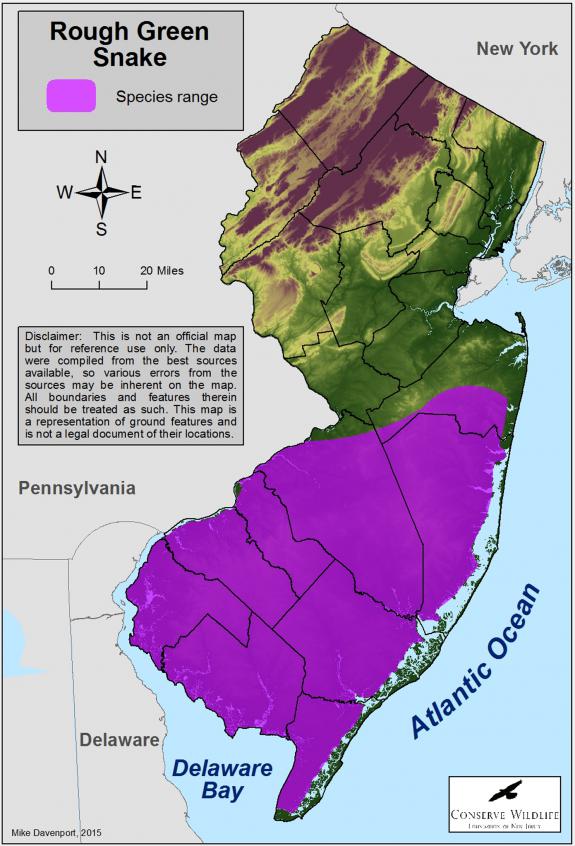Opheodrys aestivus
Type: reptile
Status: special concern
Species Guide
Rough greensnake
Opheodrys aestivus
Species Type: reptile
Conservation Status: special concern
IDENTIFICATION
As its name implies, the rough greensnake is green, light green to be exact. And its underside is white, yellow, or pale green. It grows to a length of 20 to 45 inches. It is a very slender snake, hard to find amongst vegetation due to its coloration.
The rough greensnake has keeled scales while the very similar looking smooth green snake (Opheodrys vernalis) has smooth scales.

Distribution & Habitat
The rough greensnake occurs throughout the southeastern United States, from Texas and Kansas in the west to the eastern seaboard from Florida in the south to the southern half of New Jersey in the north. Rough greensnakes are only found in the southern half of New Jersey; smooth greensnakes can be found in the northern portion of the state.
This snake prefers dense vegetation (shrubs, vines, or trees) near water. It is an arboreal species, an excellent climber often found in vegetation overhanging water.
Diet
This species eats mostly insects (especially caterpillars, grasshoppers, and crickets) and spiders.
Life Cycle
Rough greensnakes are primarily active during the day and are usually active between the months of April to November in New Jersey.
This species rarely lives longer than 6 years in the wild. Males first breed when they are about 21 months old and females at 21-33 months of age. 5-6 eggs are laid during the summer and hatch in 5-12 weeks. The eggs are laid under objects in damp areas, in rotting logs, or tree hollows and this species may nest communally. Individuals nesting within a tree may return to that same tree each year to nest.
Current Threats, Status, and Conservation
In 2016, the New Jersey Endangered and Nongame Advisory Committee recommended a Special Concern status for this species within the state and the status update was adopted in January 2025. The Special Concern status is largely due to population declines and habitat loss. Reasons for the decline in their population are loss of habitat, illegal capture for the pet trade, road mortality, and direct killing. This species, like many snakes, has an undeserved bad reputation and they are often killed, which is illegal in New Jersey.
HOW TO HELP
The Endangered and Nongame Species Program would like for individuals to report their sightings of rough greensnakes. Record the date, time, location, and condition of the animal and submit the information by submitting a Sighting Report Form. The information will be entered into the state’s natural heritage program, commonly referred to as Biotics. Biologists map the sighting and the resulting maps “allow state, county, municipal, and private agencies to identify important wildlife habitats and protect them in a variety of ways. This information is used to regulate land-use within the state and assists in preserving endangered and threatened species habitat remaining in New Jersey.”
References
- NatureServe. 2015. NatureServe Explorer: An online encyclopedia of life. Version 7.1. NatureServe, Arlington, Virginia. (Accessed: August 6, 2015).
- Schwartz, Vicki. 2002. Field Guide to Reptiles and Amphibians of New Jersey. New Jersey Division of Fish and Wildlife.
Text written by Mike Davenport in 2016.
Scientific Classification
- Kingdom: Animalia
- Phylum: Chordata
- Class: Reptilia
- Order: Squamata
- Family: Colubridae
- Genus: Opheodrys
- Species: O. aestivus